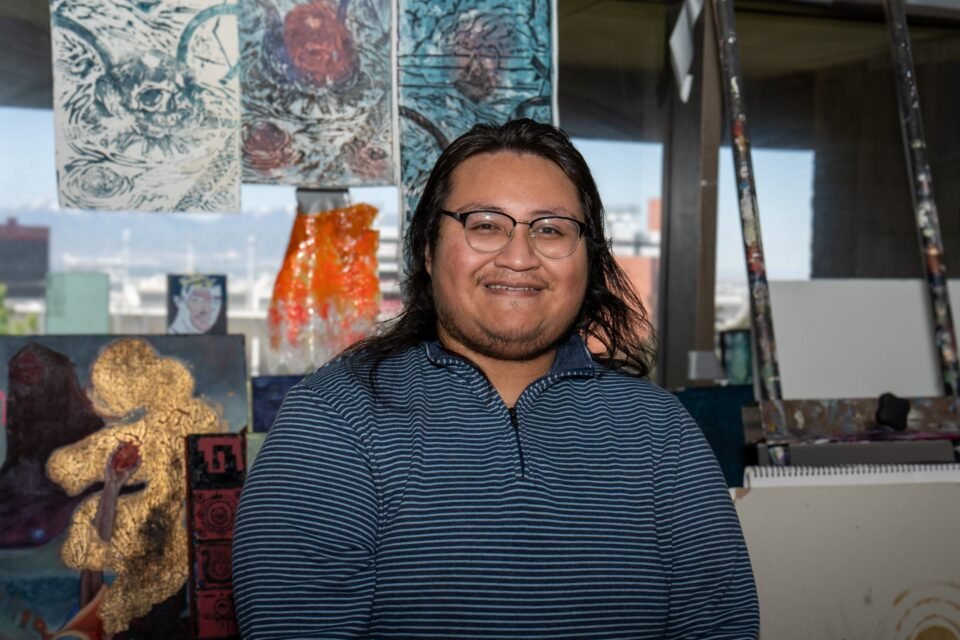Walking into Pablo Ayala’s third-floor studio at the University of Utah’s fine arts building, the space feels still. There’s a sense of reverence like stepping into a museum. Concrete slabs, fiber textures, paintings and tools are spread throughout the space.
For Ayala, an MFA student and multidisciplinary artist, this space is where stories are honored — not only their own, but those of their parents, their community and immigrant families across the country.
Their work, which will be featured in this year’s Latino Arts Festival on June 13-15 at Canyons Village, embodies the labor and sacrifices that immigrant communities make to support their families.
“Growing up here in Salt Lake as an undocumented immigrant, I saw my parents work two to three jobs every day, and most of those jobs were hard labor, construction, and I wanted to utilize my voice as an artist to recognize that work that they’re doing,” Ayala said.
Ayala’s paintings often incorporate construction materials like concrete and drywall, drawing directly from techniques they learned from their father and stepfather while growing up.
They described construction labor techniques, such as the use of stucco and concrete, as a “generational craft” — one perfected and passed down from generation to generation.
“(I’m) recognizing that there is a beauty and a sense of exoneration, that these crafts take time, and they take knowledge, and they take time to pass down,” they said.
While Ayala noted that many people don’t view these types of materials as worthy vessels for fine art, for them it enhances the piece.
“There’s so many spaces within art that are held back because of, ‘Oh, that’s not archival,’ or, ‘Oh, that’s not fine art material,’ when in reality, concrete is so durable. It has taken generations to craft the right texture, the right surface texture, the right finish, and it has so much information that goes unappreciated,” they explained. “It feels so much more meaningful to paint — using my background of almost 10 years of oil painting — on top of this material that has been in my family for generations and has been in other immigrant families for generations.”
Much of Ayala’s recent work explores the emotional toll of immigration, from the silent endurance of parents to the psychological weight placed on children. There’s the story of their parents, but also of immigrants across the country who constantly face challenges and rising fear.
Through that storytelling, Ayala said they hope others will feel less alone.
“It’s pushed me just to reimagine those stories of love and sacrifice, from parent to child into the artworks and emphasize that we’re all people and we all share stories and family, intergenerational locks, and so many other things beyond the things that separate us,” they said.
One particularly personal piece depicts Ayala picking up their father from work after his second shift — a quiet ritual they’ve shared for nearly 20 years.
“I think a lot of Hispanic families, like my dad, do not talk a lot, and it’s through art or through making artwork that I’ve learned to communicate with him in his own way,” Ayala said.

Referring to the painting of their father, Ayala reflected that they had never viewed the moment as something precious until capturing it on canvas. The finished painting depicts their father’s shadowed figure leaning against a lightpost in an empty nighttime parking lot.
“To put that into a series, or setting it into concrete, is a proof of love and a proof of that sacrifice he’s been making, and I think a lot of people can resonate with that,” they said.
During their undergraduate studies, Ayala conducted biosensor research that paired immigrant storytelling with heart rate monitoring, showing that viewers — especially immigrants — experienced improved emotional regulation when they saw themselves represented in artwork. With that research, they’ve been working with the Huntsman Institute, and are looking to do more research with other groups, like the Kimball Arts Center, to investigate their findings as it relates to children.
At this year’s Latino Arts Festival, Ayala plans to showcase the evolution of their practice from early fiber works like knitting and crotchet to concrete-based paintings and mixed media pieces. They’ll also host an interactive workshop at their booth where visitors can stop by and make their own piece of concrete art.
As an educator, Ayala has taught K–12 students through the Kimball Art Center and designed bilingual courses that merge art with science, culture and identity. In one meaningful memory from teaching a middle school outreach program, Ayala explained the impact they’re able to have on students.
They recalled being told by teachers that a student was “a little difficult and had a hard time,” but quickly realized the student primarily spoke Spanish and was struggling due to a lack of communication support. It was a humbling experience, they said, to work alongside their co-teacher, and be able to provide instruction in Spanish.
“It almost flipped the switch for that kid. They started making art. They were respectful, they were quiet. They loved making whatever craft we were doing that day, and at the end of that, I could never describe them as someone who was ‘difficult,’” Ayala said. “There was just an issue with communication, and for me to be a step for that, I could have never really hoped for something better.”
While Ayala’s internship with the Kimball Art Center ended last winter, they hope to continue working with the organization, particularly through its outreach programs.
“As someone who doesn’t really like to sit still, I am excited for the next opportunity, and I’m always looking to find what I can do for the community.”
For more: pabloayalaart.myportfolio.com.

